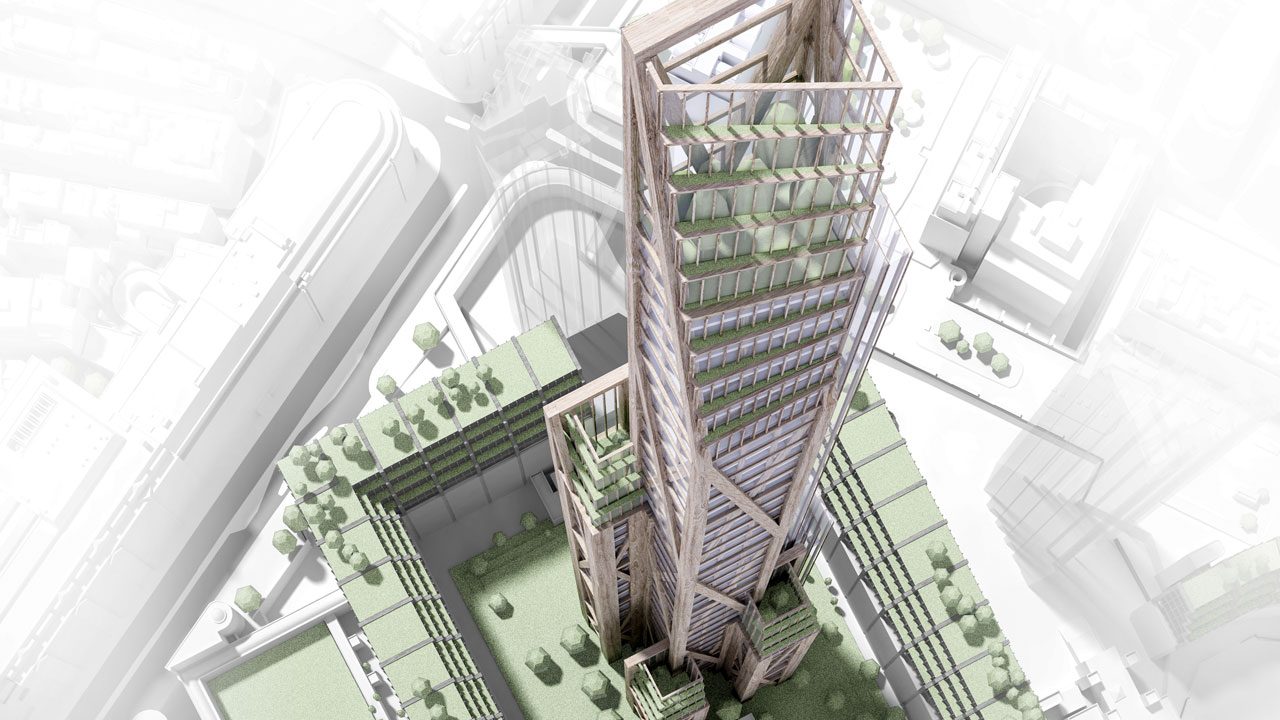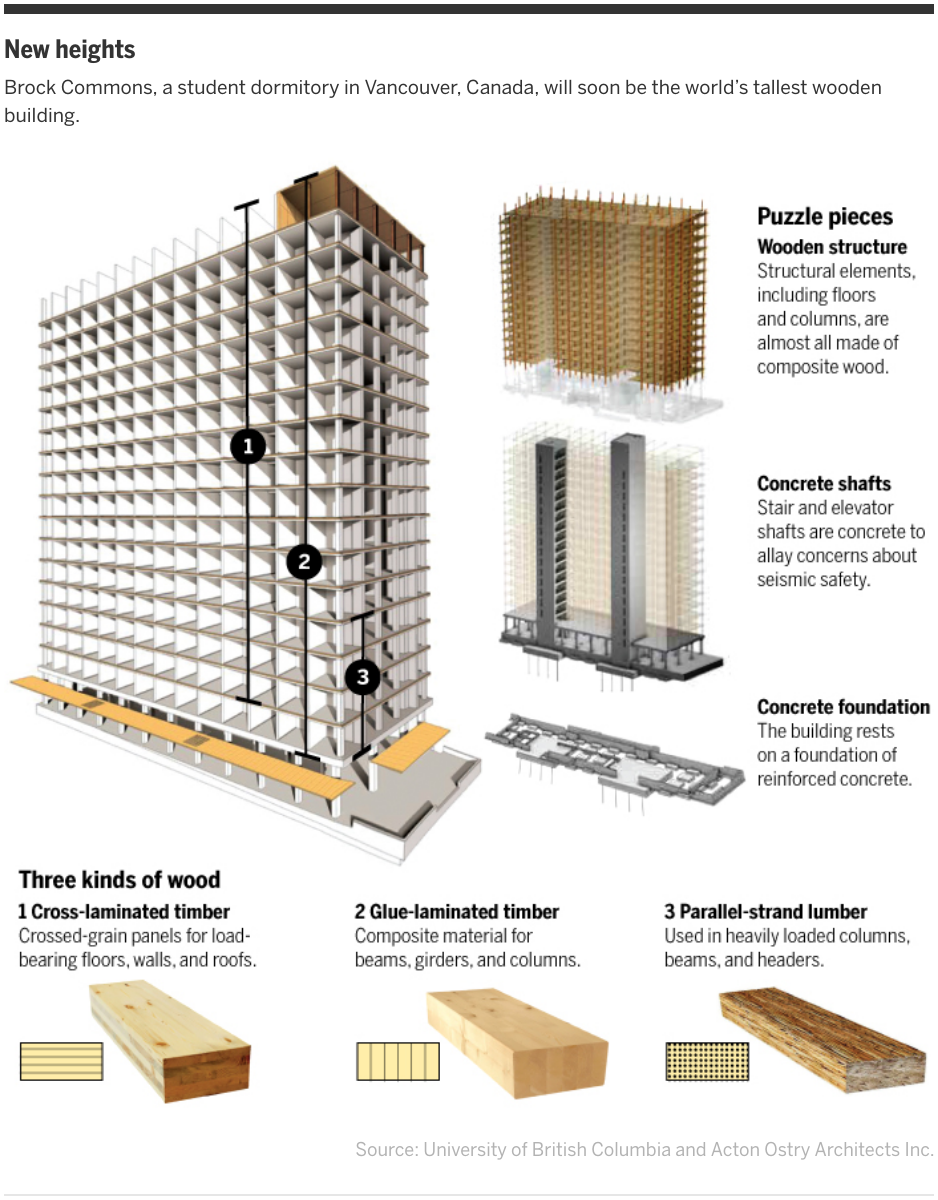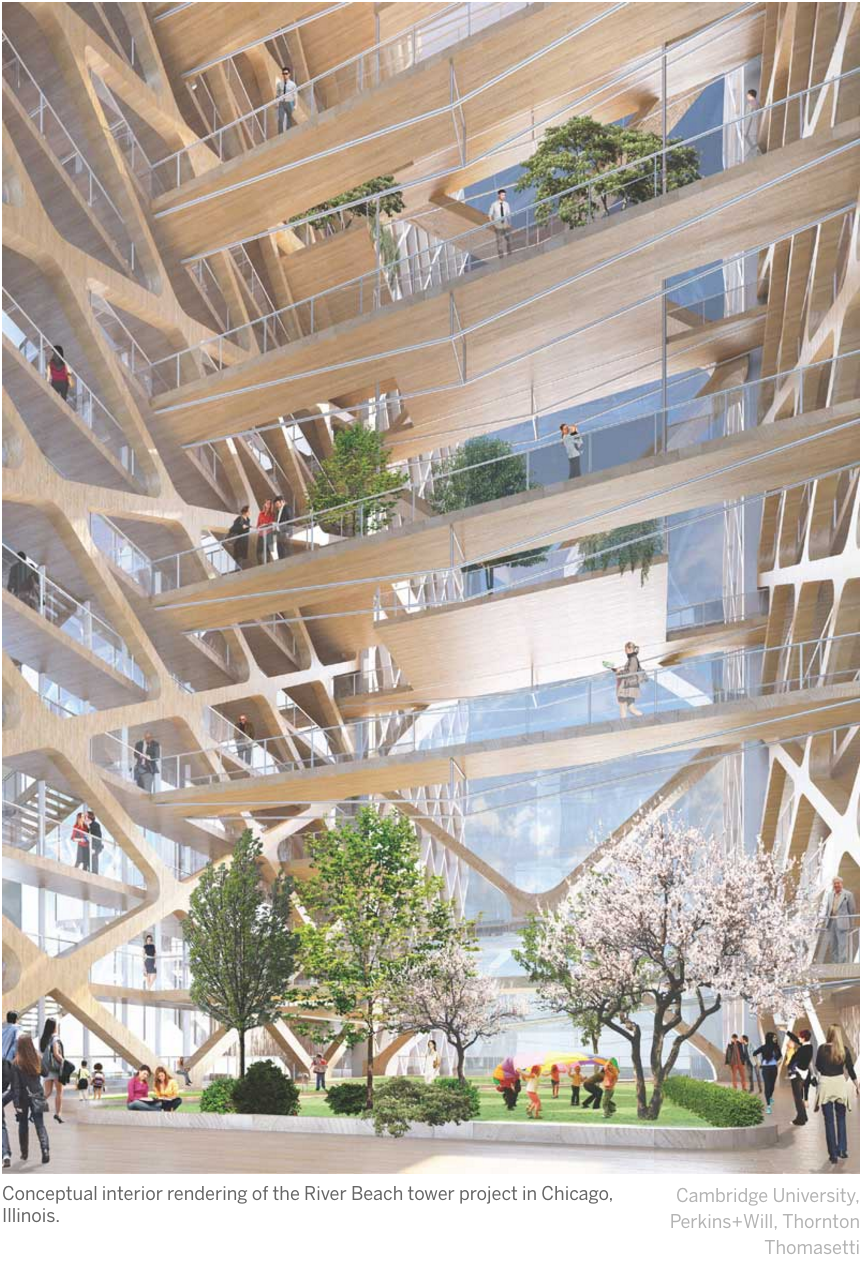A Douglas fir tree is a marvel of natural engineering. The trunk, made mostly of slender dead cells each a few millimeters long, can reach heights of 100 meters. It’s supple enough to sway in windstorms without snapping, yet strong enough to support its weight—up to 160 metric tons. Kilogram for kilogram, a wooden beam made from this fir is 3.5 times stronger than steel. A single tree can store half its weight in carbon and can replace itself, given enough time. Its luminous, patterned wood can be sculpted into virtually any shape.
Not far from Canadian forests thick with Douglas firs, the most ambitious effort yet to harness these remarkable qualities in a human structure is rising. A few kilometers from downtown Vancouver, on the University of British Columbia campus, workers are putting the finishing touches on an 18-story dormitory set to be the world’s tallest wooden building. As skyscrapers go, the boxy structure is modest. Yet it represents a leap forward for a material long regarded as too weak, variable, and flammable to support high-rise buildings.
Scientists and architects across the globe are trying to adapt this ancient building material for the demands of the modern city. Spurred by new ways to work with wood and concerns about the environmental toll of urban construction, they are trying to push the limits of height for wood construction and win wider acceptance for its use.
“We’re in sort of the early, early days of this,” says Michael Green, a Vancouver architect who has gained international attention for evangelizing about the potential for tall wooden buildings. “Right now I liken it to kind of the beginning of the steel revolution 120 years ago.”
The Vancouver building, assembled from composite wooden components engineered to be stronger and more fire-resistant than ordinary wood, is unlikely to remain the tallest wooden structure for long. Engineers have conceived designs for soaring wooden skyscrapers that, at up to 80 stories, would rival their steel-framed cousins. But wood’s true potential for 21st century cities is likely to emerge in the lab, where scientists are conducting myriad torture tests on new designs for wooden walls, beams, ceilings, and floors. Their goal: to see whether wood can overcome the safety concerns that, in the past, helped relegate it to the little leagues.
In 2013, Green’s 29-meter-tall Wood Innovation and Design Centre in Prince George, Canada, earned bragging rights as what was then the tallest wooden building in North America. But it came with this qualifier: the tallest modern one. A 111-year-old building not far from his office in Vancouver rises 34 meters, supported by massive beams carved from old-growth Douglas firs. “It’s hard to feel like you’re some hero of science or innovation when you’re trying to keep up with what we used to do,” Green says ruefully.
When true skyscrapers started rising in the late 19th century, wood’s drawbacks began to loom. Its cells act like little sponges, swelling and shrinking by as much as 10% as they absorb and release moisture. Knots and twists in the grain make wood behave in unpredictable ways. It’s more brittle than steel and more bendable than concrete. It rots, and, of course, it burns.
This final quality played a pivotal role in its decline as a structural material for large buildings, says David Barber, a Washington, D.C.-based fire engineer and expert in wooden buildings at the engineering firm Arup. As fire storms swept through cities built chiefly of wood—San Francisco, California, in 1851 and 1906; Chicago, Illinois, in 1871; Boston in 1872—insurers and officials discouraged tall wooden buildings in favor of less combustible material. Wood was consigned to low-rises and single-family houses.
The beams and panels in today’s tall wooden buildings, however, are a far cry from natural wood. Instead of being hewn from a single tree, they’re made of myriad bits of wood, glued together in a range of patterns. For tall buildings, a key innovation is known as cross-laminated timber, or CLT. Imagine plywood on a huge scale. Long pieces of lumber much like standard two-by-fours are glued together edge to edge, forming sheets. Those sheets are then pressed together in three or more layers, the wood in each layer running perpendicular to the adjacent sheets.
Developed in Europe in the 1990s, CLT has several advantages over conventional wood. The perpendicular layers counter wood’s tendency to warp and twist and add strength. Individual wood pieces can be selected to create a more uniform final product. Sheets of CLT can span gaps of 18 meters—wide enough to serve as the floor for a multistory building. For going tall with wood, “CLT was kind of the trigger,” says Erol Karacabeyli, a veteran engineer at a Vancouver lab of FPInnovations, a nonprofit created by the Canadian government and the timber industry to find new ways to use wood.
At FPInnovations, Karacabeyli leads the way into a cavernous room, where CLT panels 17 centimeters thick and 8 meters long, like those making up the floors in the new wooden dorm nearby, lie in a stack. They were being tested to see how much weight they could handle. Or, as Karacabeyli puts it, “So what happens if you have a really big party?”
Although CLT has been around for a quarter-century, tall wooden buildings are only now taking off. Credit growing concerns about climate and computer advances that make it easier to fashion custom-shaped panels, says Sam Zelinka, head of building and fire sciences research at the Forest Products Laboratory, an arm of the U.S. Department of Agriculture, in Madison. “The carbon thing has got people thinking about—I don’t know what kind of word you want to use—sustainability and greenness,” he says.
Besides being renewable, wood proponents argue, timber offers a double helping of carbon benefits. It’s less energy intensive to produce than steel and concrete. And the wood in a building effectively sequesters carbon, while trees regrowing in logged areas can absorb additional carbon dioxide (CO2). A report from the University of Canterbury in Christchurch, New Zealand, estimated that throughout its entire life, a large building made mostly from wood would have a carbon footprint a third smaller than a comparable one made from steel or concrete.
On a global scale, replacing the steel used in construction with timber such as CLT could cut CO2 emissions by 15% to 20%, according to a 2014 study in the Journal of Sustainable Forestry. “It’s amazing what can be done,” says Chad Oliver, the study’s lead author and head of the Global Institute of Sustainable Forestry at Yale University.
But others question those projections. William Keeton, a forest ecologist at the University of Vermont in Burlington, found in a 2010 study that a New England forest left alone or lightly logged for more than a century would store approximately a third more carbon than a more heavily logged forest plus the wood products coming from it. He also cautions that it’s hard to predict whether swapping wood for steel would lead to a perfect one-to-one exchange. For example, building designs could change in response to the shift in materials. “We just have to be a little careful to recognize that wood products are not the panacea,” he says.
A mass switch to wood could also have major implications for forests. Oliver estimates that replacing the world’s structural steel with wood could require 40% of global annual forest growth—almost a tripling of today’s logging levels. That’s still less than the new wood grown in forests each year, Oliver says. But given today’s logging techniques, he says, “we would have a lot of highly degraded forests.”
The push to demonstrate the potential of wood has touched off a skyscraper race. The new Vancouver dormitory risks being surpassed by a 21-story residential tower in Amsterdam, scheduled to start construction in 2017. In April, Michael Ramage, an architect and structural engineer at the University of Cambridge in the United Kingdom, unveiled a plan for a needle-thin, 80-story skyscraper in London, one of four designs he’s creating with architects in three different cities. There’s no imminent plan to build any of them. But Ramage predicts that wooden towers this tall could go up within a decade, and he and his colleagues are now testing the kinds of beams and steel connectors that could support a supertall wooden structure.
Others, meanwhile, are campaigning to change building codes that, in most of North America, cap wooden buildings at six stories. The Vancouver dormitory is a case in point: Its designers had to apply for a special exemption from the building code. To assuage fire safety concerns, they sheathed its interior wooden columns in three layers of sheetrock. They also used reinforced concrete for the first floor and two major rectangular cores housing the elevator and stairs. The cores could have been built of wood, but doing so could have made it even harder to win government permits. “Until these kinds of innovative products or design methods or construction methods are in the code, they’re not likely to be widespread,” says Eric Karsh, a principal engineer at Equilibrium Consulting in Vancouver, who has worked on other tall wooden buildings.
Government, university, and private scientists are now doing the meticulous tests that could make future building codes friendlier to wood. The Vancouver dorm will be outfitted with motion sensors and moisture detectors as scientists gauge how the building endures perhaps its most brutal trial—housing 400 college students. In the United States, scientists plan to erect a 10-story wooden building on a massive earthquake simulator at the University of California, San Diego, in 2020, to see how well a seismic protection system performs. Another group is setting off explosives near CLT-built walls to test how they would withstand a blast. Others are igniting a model apartment lined with CLT to see how the interior burns.
Barber, the fire engineer, says that much of the rap against wood reflects confusion between familiar wood-framed buildings, built of small, combustible lumber, and tall ones with massive timbers. Those huge pieces of wood actually withstand fire well, burning slowly and predictably, he says. An exterior layer of charred wood insulates the center of the timber, helping preserve its strength. “The science is somewhat already proven,” Barber says. “It’s more the case of the construction industry getting more familiar with how these buildings can be constructed and that they can be constructed safely.”
The results so far have won over officials in Quebec in Canada, which last year raised the height limit to 12 stories for buildings using so-called mass timber. In the United States, the International Code Council, whose rulebook guides local building codes, announced in January that it was forming a committee to evaluate tall wooden buildings.
Meanwhile, a handful of U.S. architects and developers are already moving forward. Alan Organschi, a Connecticut architect who teaches at Yale, wants to turn four blocks of downtown New Haven into a thicket of wooden mid-rise buildings ranging from six to eight stories. The project, called Timber City, envisions as many as 12 buildings in a former industrial neighborhood near the Yale campus. He’s now working with a developer to build the first—a six-story mix of apartments and shops.
For Organschi, like many in the field, the measure of success will be when a new 10-story wooden building is considered as unremarkable as the antique sitting in downtown Vancouver once was. “If we could get up to eight to 10 stories and really build it well and efficiently, I think we’d start to see real gains,” he says. “I think we’d have a more renewable way of thinking about city building.”





